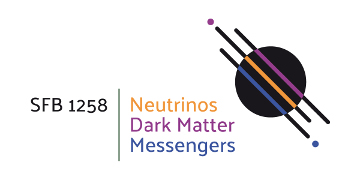Research at the SFB1258
The Collaborative Research Center “Neutrinos and Dark Matter in Astro- and Particle Physics” (SFB 1258) focuses on fundamental physics, where the weak interaction, one of the four fundamental forces of nature, is central.
While everyday phenomena on Earth mostly result from the electromagnetic and the nuclear force, the gravitational force and the weak interaction rule the heavens: Weakly interacting particles dominate the dynamics of galaxies and larger scale cosmic structures in a yet unknown form that we call dark matter. Neutrinos are assumed to determine the process of producing ordinary matter in the early universe as well as being central for the evolution of collapsing stars. High-energy neutrinos in turn provide a new window to the most energetic processes in the universe. The SFB1258 addresses these questions organized in three areas: Neutrinos (area N), Dark matter (area D) and Messengers (area M).
Area N: Neutrinos
Fundamental questions
We investigate open key questions: Are neutrinos their own antiparticles? What are the absolute neutrino masses? Where did neutrinos originate from?
Area D: Dark matter
Elusive particles
We pursue this task with different experimental and phenomenological strategies, ranging from direct and indirect detection approaches to signature searches at the Large Hadron Collider at CERN.
Area M: Messengers
New window
With the South Pole observatory IceCube we can observe neutrinos as astrophysical messengers so that these particles open a new observational window on the universe.


